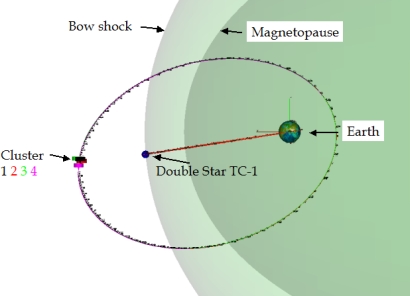No. 1 - Instrument Commissioning Started
This should not affect the scientific objectives. Furthermore, the spacecraft will now observe the Earth bow shock, which was not in the original scientific objectives. A preliminary estimate reveals that that the number of conjunctions with Cluster has decreased slightly, but this is compensated by the longer time interval for each individual conjunction.
 |
|
Double Star and Cluster orbits |
Spacecraft Status
One solid boom, carrying the fluxgate magnetometers (FGM), has been deployed successfully. The other one, carrying the search coil (STAFF/DWP), is still un-deployed after an initial attempt to deploy it. Chinese spacecraft engineers are investigating the source of the problem and will make another attempt in the next few weeks. This, however, does not affect the stability of the spacecraft and the spin axis is as expected close to the North ecliptic pole.
Instrument Commissioning
Instrument commissioning started in early January.
FGM
Commissioning Status: Tests started on 8 January and after 4 days the instrument electronics were checked-out successfully.
Current Operations: Data acquisition is now taking place to calibrate the instrument.
STAFF/DWP
Commissioning Status: Has finished its initial commissioning
Current Status: Instrument is functioning nominally.
Both instruments have detected an electromagnetic noise, which is likely related to the boom asymmetry causing solar array shadowing; an investigation is on going to identify the source and try to eliminate it.
PEACE (electron detector)
Commissioning Status: Started first electronic tests on 20 January and is working nominally. Some software tuning is still on going to optimize the on-board compression algorithm.
Current operations: An increase in solar activity (M6.1 flare) started on 21 January and an interplanetary shock arrived at the Earth on 22 January around 01:35 UT. The effect on the magnetosphere was a big compression, due to the increased pressure of the solar wind by about 5 times more than usual, and the Earth bow shock was pushed toward Earth and passed the Double Star located at 12.6 Earth radii, as indicated by preliminary PEACE data. The Cluster spacecraft were also in the solar wind and observed the interplanetary shock and this conjunction should allow a very detailed study of the event.
ASPOC (ion emitter)
Commissiong Status: Covers were opened successfully on 5 January and instrument commissioning will began on 24 January
Current operations: Three ion emitters were successfully ignited and are working nominally. The fourth, and final emitter, will be ignited during the next communications visibility slot on 28 January.
HIA (ion detector)
Commissiong Status: Commissioning will begin in first half of February
Other News
All three European experiments are being delivered to Beijing for the second Double Star spacecraft, which will start its integration early February for a launch in July 2004.
Contacts
Philippe Escoubet
ESA Double Star Project Scientist (SCI-SH), ESTEC
Tel: +31-71-565-3454
Bodo Gramkow
ESA Double Star Payload Project Manager (SCI-PRD), ESTEC
Tel: +31-71-565-4564

